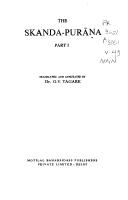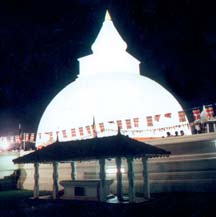
Murugan slaying the demon Surupadam
http://en.wikipedia.org/wiki/Murugan

Ganesha helps Murgan marry Valli
http://pongi.org/valli-purana.htm
Skanda/Murugan: The Legend
http://en.wikipedia.org/wiki/Murugan and
Shiva, on the immolation of Sati, withdrew from the world and engaged himself in yogic meditation in the Himalayas. The gods (devas) realized that only the son of Shiva could help them defeat the demons Surapadman, Tarakasuran, and their companions. The devas got Kama, the god of love, to shoot a flower arrow to make Shiva fall in love with Parvathi. Disturbed Shiva opened his third eye and burned Kama to ashes, but the goal of getting Shiva to marry Parvathi was archived. The resulting sparks of the fiery seed oozing out (hence Skanda) of Shiva were unbearable for Vayu the wind God; even the fire God Agni could not bear them; this fire was then transported by the river Ganga into the Saravana (reed) forest (hence the name Sarvanabahva) where the sparks became six children. They were raised by the six Krittika or Kartika - the stars that make up the Pleiades, earning the name Karthikeya. Parvathi combined these six babies into one with six faces, i.e. Shanmukha or Arumugan . Murugan as a youth (hence Kumara), became the supreme general of the devas and lead them to victory with Surupadam becoming the mount (peacock) of Subrahmanya. There are other legends and variants but the above one is the most consistent. Other related legends detail various aspects of the life of Murugan including how he wooed Vali, a tribal chieftain's daughter with the help of Ganesha, his brother. Devayani, the daughter of Indra is the other consort of Subrahmanya. Read on for more information.
Read on | Sakanda in History | Skanda in Buddhism
Skanda/Murugan: The origin of OM
OM (also AUM, ॐ in Devanagari, ஓம in Tamil, 唵 in Chinese etc. ) is the mystical or sacred syllable in the Indian religions, including Hinduism, Sikhism, Jainism, and Buddhism. It signifies the alpha and the omega, the begriming, the end and everything in between. It is the primal sound. Om, therefore, represents both the unmanifest (nirguna) and manifest (saguna) aspects of God. That is why it is called pranava, to mean that it pervades life and runs through our prana or breath. The origin of the word OM is shrouded in legend. The Vedas for example do not mention the word OM as it was very sacred and was not to be used without initiation derived from relegious penance (contrast that with today where OM is a t-shirt staple).
While there are variants to the story, in one, Murugan is supposed to have expounded the meaning of OM to his father own father Shiva. In this variant, Murugan asked Brahma the meaning of the word OM and when he could not explain it correctly, Brahma was imprisoned by Murugan and later freed when Shiva agreed to be initiated in the meaning of the word by becoming Murugan's disciple. This happened in Swamimalai, hence the name Swaminatha. A variant of this legend is where Brahma refused to explain the meaning of OM to Karthikeya as Brahma he was not ready and Karthikeya attacked him. When Shiva realized that Karthiekya was well aware of the meaning of this word OM, he asked Kumara to go to the world to propagate it. Symbolically, these stories indicate the qualities of Shanmuga, as one who is erudite and possessor of the essence of knowledge.
About Ettukudi Murgan Temple |Getting to Ettukudi and pooja timings
Skanda/Murugan: Historical References
![]() References to Skanda abound both in ancient Tamil and Sanskrit literature as well as religious works. The most quoted one is Krishna detailing the omniscience and omnipresence of God through various manifestation in Chapter 10, verse 24 of the Bhagavad Gita, "...... Senaninam Aham Skandah (among the generals I am Skanda;) .....".
References to Skanda abound both in ancient Tamil and Sanskrit literature as well as religious works. The most quoted one is Krishna detailing the omniscience and omnipresence of God through various manifestation in Chapter 10, verse 24 of the Bhagavad Gita, "...... Senaninam Aham Skandah (among the generals I am Skanda;) .....".
Verse 36 of the Vishnu Sahasranamam, reads "skandah skanda-dharo dhuryo ...". Hindu scriptures often can be interpreted in multiple ways, one way be the normal way, the other being at a much higher symbolic or intellectual level. For example, skandah can be refer to being Skanda. Delving deep into meaning, Adi Sankara's interpretation is , Skanda also can mean one who melts like butter
when it comes to helping His devotees, or flows like nectar in the thoughts
of His bhakta-s - skandati iti skandah (This is a reference to the flow). Similarly, Skanda-dhara could mean either just the supporter of Skanda (the commander in chief) or as per Adi Sankara's deeper interpretation, the follower of the righteous path. This is the what Skanda Bhakti is: following the correct path.
reads "skandah skanda-dharo dhuryo ...". Hindu scriptures often can be interpreted in multiple ways, one way be the normal way, the other being at a much higher symbolic or intellectual level. For example, skandah can be refer to being Skanda. Delving deep into meaning, Adi Sankara's interpretation is , Skanda also can mean one who melts like butter
when it comes to helping His devotees, or flows like nectar in the thoughts
of His bhakta-s - skandati iti skandah (This is a reference to the flow). Similarly, Skanda-dhara could mean either just the supporter of Skanda (the commander in chief) or as per Adi Sankara's deeper interpretation, the follower of the righteous path. This is the what Skanda Bhakti is: following the correct path.
 Of the ancient religious works that detail Skanda's exploits, the Skanda purana, (the longest of the the main or maha Puranas with 88000 verses), as the name suggests is devoted mainly to the life and deeds of Karthikeya. The Skanda Purana contains a number of legends about Shiva, and the holy places associated with Shiva and Karthikeya. The Kanda Purānam, or Tamil version of the Skanda Purana, was written by Kachiappa Sivāchāryar of Kumara Kottam at Kanchipuram. According to the account of Kachiappa, each day he would write his inspired account of the career of Lord Murugan, and in the evening deposit his day's work in the mūlasthāam of Lord Subrahmanya at Kumara Kottam. Each night, miraculously, the Lord Himself would modify Kacciappa's manuscript with His own corrections. Hence, the Kanda Purānam is considered to be the absolutely authoritative account of Lord Murugan's career bearing the seal of approval of none other than the Lord Himself. Other references to Murugan include those in the Atharva Veda and the Taittiriya Aranyaka. There are references in both the Ramayana and Mahābhārata to the birth of Skanda and this article by Dr. Janaki is good starting point for those intersted in learning more.
Of the ancient religious works that detail Skanda's exploits, the Skanda purana, (the longest of the the main or maha Puranas with 88000 verses), as the name suggests is devoted mainly to the life and deeds of Karthikeya. The Skanda Purana contains a number of legends about Shiva, and the holy places associated with Shiva and Karthikeya. The Kanda Purānam, or Tamil version of the Skanda Purana, was written by Kachiappa Sivāchāryar of Kumara Kottam at Kanchipuram. According to the account of Kachiappa, each day he would write his inspired account of the career of Lord Murugan, and in the evening deposit his day's work in the mūlasthāam of Lord Subrahmanya at Kumara Kottam. Each night, miraculously, the Lord Himself would modify Kacciappa's manuscript with His own corrections. Hence, the Kanda Purānam is considered to be the absolutely authoritative account of Lord Murugan's career bearing the seal of approval of none other than the Lord Himself. Other references to Murugan include those in the Atharva Veda and the Taittiriya Aranyaka. There are references in both the Ramayana and Mahābhārata to the birth of Skanda and this article by Dr. Janaki is good starting point for those intersted in learning more.
There are also references to Subrahmanya in Kautilya’s Arthashastra, and in the works of Patanjal. Skanda  worship was quite common in north India as the image of a coin of the Yaudheyas (an ancient clan in Peshawar) depicts Karthikeya. The Gupta period also illustrates this. Two of the kings in this dynasty are named after Karthikeya (Skandagupta and Kumaragupta). Kalidasa the
worship was quite common in north India as the image of a coin of the Yaudheyas (an ancient clan in Peshawar) depicts Karthikeya. The Gupta period also illustrates this. Two of the kings in this dynasty are named after Karthikeya (Skandagupta and Kumaragupta). Kalidasa the  majestic poet of sanskrit literature who lived in this era, details the love between Siva and Parvathi and the defeat of Tarakasura by Karthikeya in the classic KumaraSambhava. The caves at Ellora and Elephanta have images of Skanda. There are still a few temples devoted to Skanda in North India. However the worship of Murugan has shifted to the south of India, especially Tamil Nadu.
majestic poet of sanskrit literature who lived in this era, details the love between Siva and Parvathi and the defeat of Tarakasura by Karthikeya in the classic KumaraSambhava. The caves at Ellora and Elephanta have images of Skanda. There are still a few temples devoted to Skanda in North India. However the worship of Murugan has shifted to the south of India, especially Tamil Nadu.
Other literary references abound in the Sangam literature which refers to a body of classical Tamil literature created between the years 600 BCE to 300 CE.This collection contains 2381 poems written by 473 poets, some 102 of whom remain anonymous. Murugan is glorified in Tolkappiyam, possibly the most ancient of the extant Sangam works, glorified Murugan, " the red god seated on the blue peacock, who is ever young and resplendent," as " the favored god of the Tamils." Other Sangam literature that glorifies Murugan include Paripaatal, the Akananuru and the Purananuru. In the Tamil devotional work, Thiruppugazh, arunagirinathar, the beloved poet sings of how "Murugan never hesitates to come to the aid of a devotee when called upon in piety or distress". In another work Thirumurukkarrupatai, Murugan is described described as a god of eternal youth; His face shines a myriad rays light and removes the darkness from this world.
Read about Murugan Bhakti and Murugan Hymns |Getting to Ettukudi and pooja timings
Links and References
There are many sites devoted to Murugan, and they have a wealth of material. One site that stands out is the murugan.org, created and maintained by Patrick Harrigan. It has a wealth of information, articles, references and some rare works. It would be a good starting point for anyone interested in Murugan worship and some of the pictures here have been taken from that site with permission.
Devotees please suggest additional references
About Ettukudi Murgan Temple |Getting to Ettukudi and pooja timings
Skanda in Buddhism
To the Hindu, Skanda is an important deity. In my research on Skanda, there were a few references to Skanda in Buddhism (both Chinese Buddhism and the Sinhala (Sri Lanka) version of Buddhism). In Chinese Buddhism a deity. called Skanda (Ch. 韋馱菩薩; Wei Tuo Pu Sa), Wei Tuo, and sometimes called Veda, or Idaten (韋駄天) in Japan, is regarded as a devoted guardian and an honored bodhisattva of Buddhist monasteries who guards the Dharma and the objects of the Dharma. He is also sometimes called "Wei Tuo Zun Tian Pu Sa" (meaning Honored Bodhisattva Wei Tuo) because he is one of the twenty-four celestial guardian deities. He is the General-in-Chief of the thirty-two heavenly generals who serve under the Four Heavenly Kings, each of whom watches over one cardinal direction. Another relationship is Vajrapani (from Sanskrit vajra, "thunderbolt" or "diamond" and pāni, lit. "in the hand") who is is one of the earliest bodhisattvas of Mahayana Buddhism. Some suggest that the war deity Karthikeya, who bears the title Skanda is also a manifestation of Vajrapani, who bears some resemblance to Buddhist Skanda because they both wield vajras as weapons and are portrayed with flaming halos. The buddhist legends of Skanda have references to demons begin thwarted in their attempts through the valor of Skanda.
Sri Lanka has for long been a Buddhist country with strong hindu influence. The Kiri Vehera complex houses both an ancient buddhist temple and a temple dedicated to Kataragama (Skandakumara), a temple where devotees celebrate murugan festivals in the traditional way (including Kavadi dancers). Many Buddhists on the other hand visit the Hindu temple also and participate in the festivities. They actually consider that God Kataragama is a Bodhisattva (one aspiring to be a Buddha) who has the power and compassion to intervene in the lives of those who appeal to him. This again is symbolic of what Murugan stands for and
The Kiri Vehera complex houses both an ancient buddhist temple and a temple dedicated to Kataragama (Skandakumara), a temple where devotees celebrate murugan festivals in the traditional way (including Kavadi dancers). Many Buddhists on the other hand visit the Hindu temple also and participate in the festivities. They actually consider that God Kataragama is a Bodhisattva (one aspiring to be a Buddha) who has the power and compassion to intervene in the lives of those who appeal to him. This again is symbolic of what Murugan stands for and
While there are many different legends around how Skanda was incorporated into Buddhism, clearly, there are very strong correlations that indicate the Hindu origins of the Buddhist Skanda. The clear reference to "General in Chief" is very indicative as Murugan is considered as the "Commander in Chief", as is the Buddhist Skanda. Again as per Adi Sankara's interpretation of Skanda (Karthikeya) as "follower of the righteous path" and the Buddhist version of Skanda as a bodhisattva "who guards the Dharma and the objects of the Dharma" seem erreily similar as Dharma is the righteous path. Given origins of Buddhism from Hinduism, it is not surprising that that Skanda worship has made its way to Buddhism. However it is indeed a tribute to enduring legacy of Subrahmanya and what he stands for, that paves the way for a universal fellowship that can transcend boundaries of religious sects and even countries. Buddhism has incorporated what Skanda stands for within their own structure and interpretation. It is not about how he looks or what weapons he carries or what demons he kills, it is about the the person who symbolizes the ability to protect his devotees from evil influences and effects through love, compassion and understanding. That is the essence of Murgan Bhakti.
About Ettukudi Murgan Temple |Getting to Ettukudi and pooja timings

